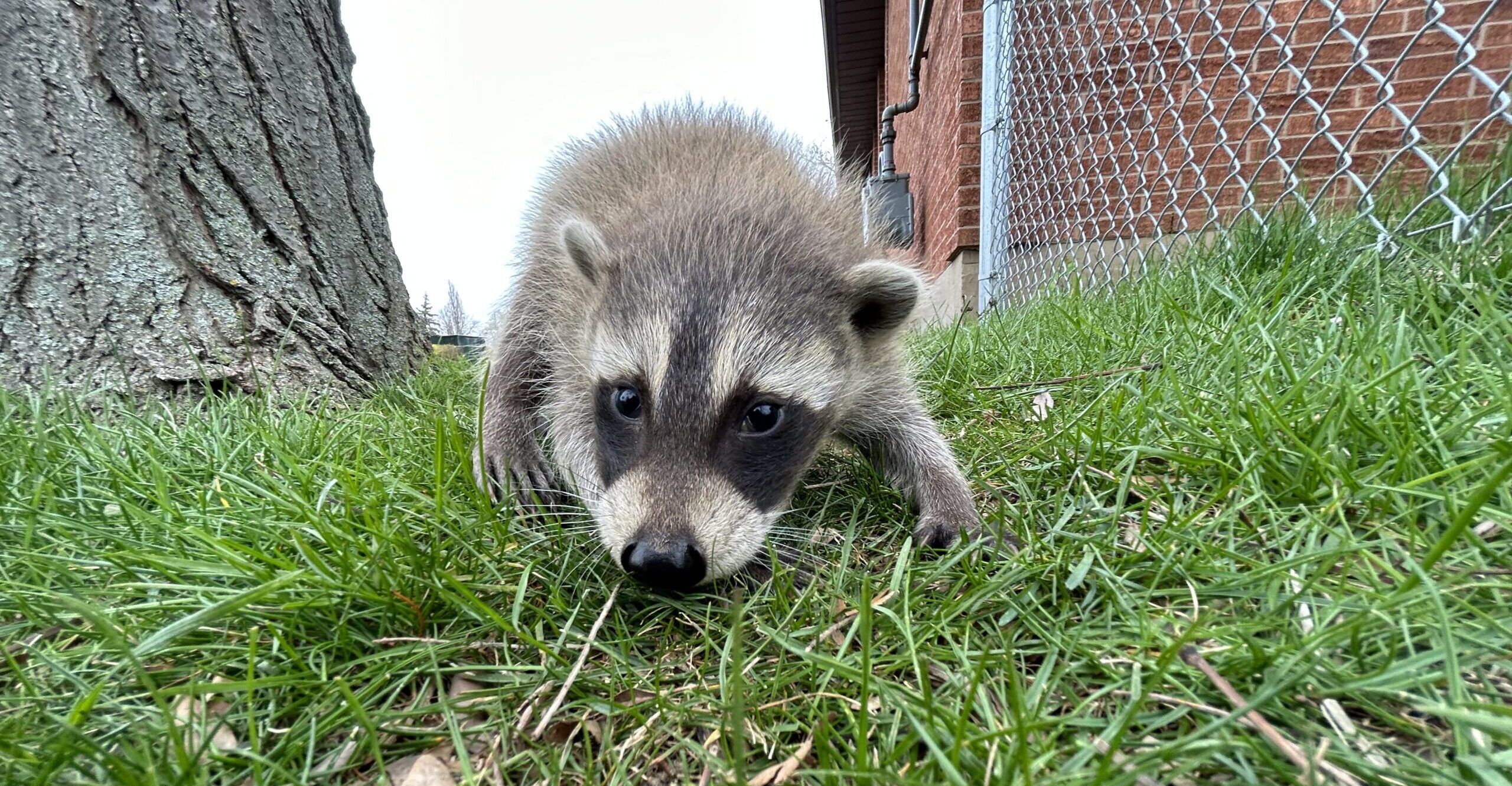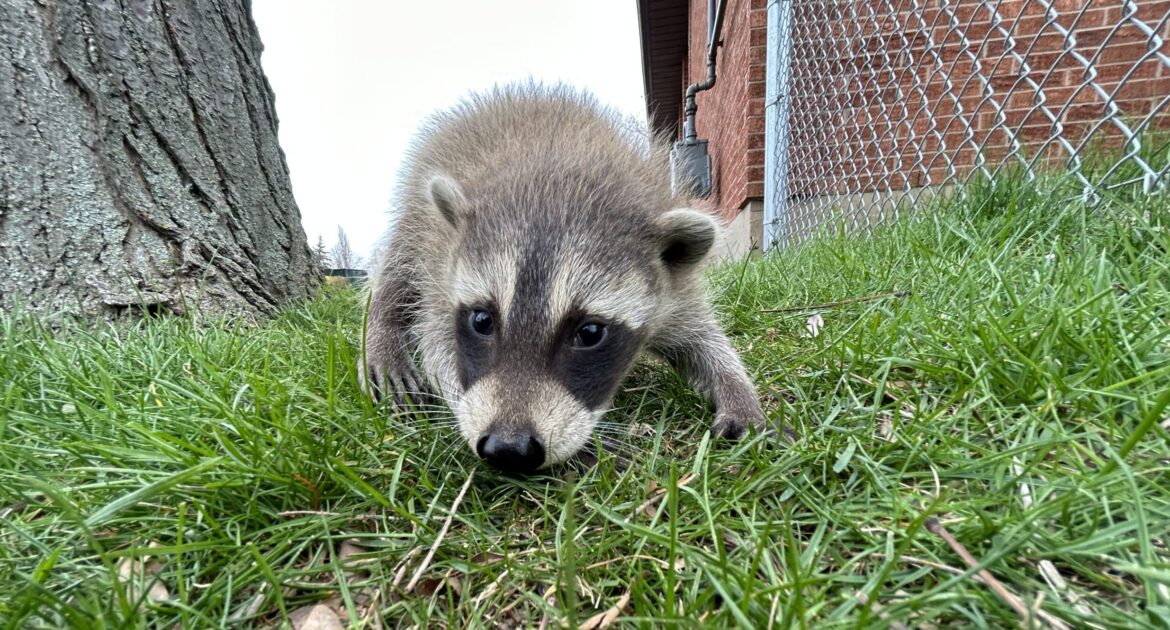Raccoons are highly adaptable creatures with intriguing eating habits that often surprise people who encounter them. Understanding the raccoon diet in the wild not only satisfies our curiosity about these masked bandits but also helps us better manage potential conflicts when they venture into our Clintonville neighborhoods. At Skedaddle Humane Wildlife Control, we’ve spent decades studying raccoon behavior, and their natural diet provides valuable insights into why they behave the way they do around our homes.
Just as the Scioto Mile provides a haven for urban wildlife, the surrounding wild areas offer these animals a diverse buffet of natural food sources. While many local residents know raccoons primarily as nighttime raiders of garbage cans, their natural diet is much more complex and varied than most people realize.
What Raccoons Eat Naturally in Their Native Habitats
Raccoons are true omnivores, meaning they consume both plant and animal matter with equal enthusiasm. Their natural diet is remarkably diverse, which explains their incredible adaptability across different environments—from the wooded areas around Highbanks Metro Park to the urban landscapes of downtown.
In the wild, a raccoon’s diet typically includes:
- Small mammals like mice and squirrels
- Birds and bird eggs
- Reptiles and amphibians
- Insects and grubs
- Crayfish, frogs, and other aquatic creatures
- Nuts, berries, fruits, and other plant matter
- Seeds and grains
This varied menu allows raccoons to thrive in almost any habitat and adapt quickly to changing conditions. Their opportunistic feeding habits are a key reason they’ve been so successful in both wild and urban environments.
The Importance of Aquatic Foods in the Raccoon Diet
One lesser-known aspect of the raccoon’s diet in the wild is their strong preference for aquatic foods. Raccoons are skilled hunters in shallow water, and their scientific name Procyon lotor (which translates roughly to “washer dog”) refers to their habit of dunking food in water—a behavior many people misinterpret as washing.
Water habitat hunting: Raccoons will wade into streams, ponds, and wetlands to hunt for food, using their sensitive front paws to feel for prey beneath rocks and in mud.
Preferred aquatic foods: Their water-based diet commonly includes:
- Crayfish
- Small fish
- Frogs and tadpoles
- Freshwater mussels and clams
- Aquatic insects
This affinity for aquatic environments explains why raccoons are frequently spotted along the Olentangy and Scioto Rivers, as well as around neighborhood ponds and drainage areas. These water sources provide both hydration and some of their most nutrient-dense natural foods.
Seasonal Variations in Wild Raccoon Feeding Habits
Raccoons adjust their diet dramatically as seasons change, displaying remarkable dietary flexibility that helps them survive year-round. Understanding these seasonal patterns provides insight into when raccoon activity might increase around human dwellings.
Spring Diet (March-May)
- Early plant growth: As plants begin to sprout, raccoons consume young shoots, early berries, and newly grown vegetation.
- Increased protein sources: They actively hunt for bird eggs and newly hatched animals.
- Insects and grubs: As soil warms, raccoons dig for grubs, earthworms, and emerging insects.
During spring, raccoons become more active as they recover from winter and prepare for breeding season. This is when we often see increased foraging activity around residential areas as natural food sources are still developing.
Summer Diet (June-August)
The summer months represent peak feeding time for raccoons in the wild. Their natural diet during this period is incredibly diverse and abundant:
- Fruits and berries: Summer brings ripening fruits like mulberries, blackberries, and wild grapes that they eagerly consume.
- Garden crops: While not their natural habitat, raccoons will readily feast on garden vegetables like corn and melons if available.
- Abundant protein: Summer provides excellent hunting opportunities for small mammals, reptiles, and amphibians.
Wild raccoon feeding habits during summer often involve more nocturnal activity, as they forage extensively to build fat reserves for the coming winter. This is particularly important for mother raccoons supporting growing kits.
Fall Diet (September-November)
As temperatures drop across Clintonville, the raccoon diet shifts again:
- Nuts become a dietary staple, especially acorns, hickory nuts, and walnuts.
- Fallen fruits are consumed in large quantities.
- Increased consumption of protein sources to build fat reserves.
- Expanded foraging range as they prepare for winter.
This is when they are at their most active and may venture closer to human habitations if natural food sources become limited. Their strong drive to accumulate body fat before winter makes them particularly determined foragers during autumn months.
Winter Diet (December-February)
Winter represents the most challenging feeding period for wild raccoons:
- Reduced activity: They don’t truly hibernate but enter a state called torpor during very cold periods, reducing their overall food requirements.
- Stored body fat: They rely heavily on fat reserves built during fall.
- Opportunistic feeding: They emerge during warmer winter days to forage for whatever food remains available.
- Emergency food sources: Tree bark, dormant insects, and even carrion may be consumed when preferred foods are unavailable.
During winters, raccoons that haven’t established dens in heated structures may face significant dietary challenges, especially during harsh weather periods. This explains why securing entry points to your home before winter is crucial.
Foraging Behaviors: How Raccoons Find Food in the Wild
Understanding how raccoons locate and process food helps explain their sometimes frustrating behaviors around human dwellings. Their foraging techniques have evolved over thousands of years and make them exceptionally successful omnivores.
The Role of Raccoon Paws in Feeding
Raccoons possess exceptionally sensitive front paws with dexterous “fingers” that give them almost human-like manipulation abilities:
- They can grasp small objects with precision.
- Their touch sensitivity increases underwater, allowing them to locate hidden prey.
- They can open complex containers, shells, and husks to access food.
- Their paws help them climb trees to reach fruits, nuts, and bird nests.
This manual dexterity is exactly why raccoons are so adept at opening garbage cans, compost bins, and other food storage containers around Clintonville homes. What works for finding crayfish under rocks also works for opening your garbage can!
Nocturnal Hunting Strategies
- Sharp senses: While they have good eyesight, raccoons’ hearing and sense of smell are exceptional, allowing them to detect food sources from considerable distances.
- Methodical searching: They typically follow regular routes when foraging, checking reliable food sources in sequence.
- Cooperation: Though not truly social animals, raccoons sometimes forage in family groups, especially mothers with growing offspring.
- Memory: Raccoons have excellent spatial memory and will return to productive feeding grounds repeatedly.
These natural foraging behaviors explain why raccoons that find food near your home will likely return night after night unless deterrence measures are put in place.
How Understanding Raccoon Diet Helps Prevent Conflicts
Knowledge about what raccoons eat naturally provides valuable insights for homeowners looking to minimize wildlife conflicts. By recognizing what attracts raccoons in the first place, you can take proactive steps to make your property less appealing.
Natural Diet vs. Human Food Sources
Raccoons have clear preferences when it comes to food, and understanding these can help with prevention:
- High-value foods: Foods high in fats, proteins, and sugars are irresistible to them.
- Ease of access: Raccoons will choose easily accessible food over food that requires significant effort.
- Consistency: Regular food sources (like nightly pet food left outdoors) quickly become part of a raccoon’s routine.
- Quantity: Abundant food sources will attract multiple raccoons and keep them coming back.
This explains why unsecured trash cans, pet food bowls, and bird feeders are such powerful attractants. Homeowners can significantly reduce raccoon visits by securing trash, removing pet food, and modifying bird feeder locations.
Protect Your Property with Skedaddle
If raccoons are causing issues on your property or you wish to prevent conflicts, reach out to Skedaddle Humane Wildlife Control. With a deep understanding of raccoon behavior and diet, our team can provide effective strategies to safeguard your home. Protect your property and enjoy peace of mind by contacting us today for professional wildlife management.




